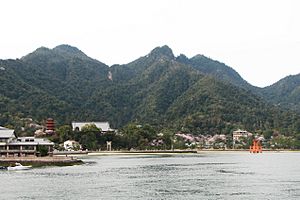Kōji (Muromachi period) facts for kids
Kōji was a special name for a period of time in Japanese history. It's like how we have years, but in old Japan, they also used "era names" called nengō. The Kōji era came after the Tenbun era and before the Eiroku era. It lasted from October 1555 to February 1558. During this time, two emperors ruled Japan: Emperor Go-Nara and Emperor Ōgimachi.
Key Events of the Kōji Era
- 1555 (Kōji 1): A small border war happened between powerful leaders, called daimyos, from Aki Province and Suō Province. Daimyos were like local warlords or governors.
- 1555 (Kōji 1): In November, a famous battle took place. Mōri Motonari, a strong daimyo, won the Battle of Itsukushima. This battle is also known as the "Battle of Miyajima" because it happened on Miyajima Island.
- 1555 (Kōji 1): Another important fight, the Battle of Kawanakajima, also happened this year.
- 1556 (Kōji 2): The Mori clan, led by Mōri Motonari, gained control of the Ōmori silver mine. This mine was very important for wealth.
- 1557 (Kōji 3): On September 27, Emperor Go-Nara passed away at 62 years old.
Related Pages
| Kōji | 1st | 2nd | 3rd | 4th |
|---|---|---|---|---|
| 1555 | 1556 | 1557 | 1558 |
| Preceded by: Tenbun |
Era or nengō: Kōji |
Succeeded by: Eiroku |

All content from Kiddle encyclopedia articles (including the article images and facts) can be freely used under Attribution-ShareAlike license, unless stated otherwise. Cite this article:
Kōji (Muromachi period) Facts for Kids. Kiddle Encyclopedia.

